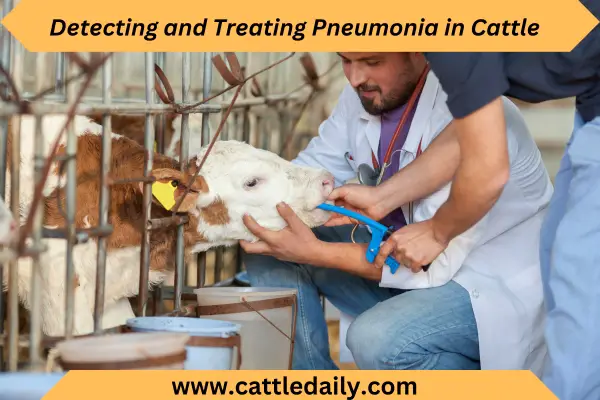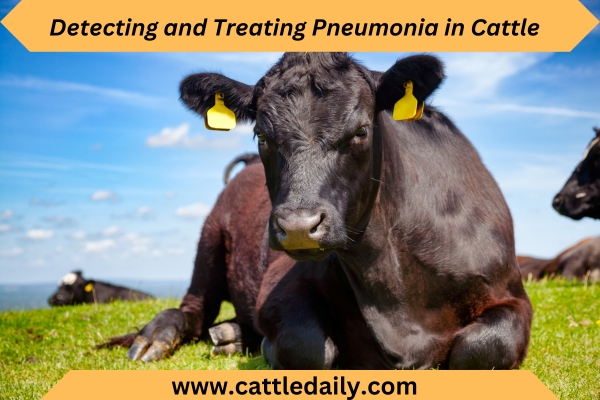Detecting and Treating Pneumonia in Cattle
Pneumonia is a common and serious illness affecting cattle herds worldwide. It is a major cause of economic loss in the cattle industry due to increased mortality, reduced growth rates, and decreased milk production and treatment costs.
Detecting and treating pneumonia early is crucial to limit its impact on cattle health and farm profits. In this article, we will discuss about causes, detection, and treatment of pneumonia in cattle herds.
What Causes Pneumonia in Cattle?
Pneumonia is a complex disease with multiple potential causes. Understanding the various factors that can lead to pneumonia is key for effective prevention and control on cattle operations. Pneumonia results when lung defenses are overwhelmed by infectious agents and environmental stressors.
Common Bacterial Causes
Several species of bacteria are frequently implicated in cases of bovine pneumonia:
- Mannheimia haemolytica – This bacterium is one of the most common causes of pneumonia in feedlot cattle. M. haemolytica secretes a toxin called leukotoxin that destroys white blood cells and damages lung tissue, allowing unchecked replication. Outbreaks are often triggered by stress.
- Pasteurella multocida – A common pathogen carried by many healthy cattle that can multiply rapidly to cause pneumonia when animals are immunocompromised. P. multocida has numerous virulent subtypes with differences in capsule composition.
- Histophilus somni – This organism can cause pneumonia on its own but is also known to play a synergistic role with Mannheimia haemolytica, exacerbating lung pathology. H. somni bacteria have multiple virulence factors that enable them to avoid immune defenses.
- Mycoplasma species – Unlike typical bacteria, Mycoplasma lack a cell wall which allows them to evade detection by the immune system. M. bovis is one of the most frequently isolated mycoplasmas from pneumonia cases in feeder cattle.
These respiratory pathogens often reside harmlessly in the upper airways of cattle. But factors like viral infection, stress, and previous lung damage enable the bacteria to multiply dramatically and infect the lungs.
Viral Pneumonia Triggers
Viral respiratory infections are a major predisposing factor for bacterial pneumonia in cattle. Viruses impair lung defenses in these ways:
- Bovine respiratory syncytial virus (BRSV) – Binding and fusion of the virus to lung cells causes cellular damage and death. BRSV destroys the cilia that normally clear mucus and debris from airways.
- Parainfluenza type 3 (PI3) – The virus infects and kills ciliated epithelial cells lining the trachea and upper airways. This impairs the mucociliary clearance mechanism.
- Bovine viral diarrhea virus (BVDV) – Immune suppression caused by BVDV inhibits normal lung immune function and bacterial clearance. Secondary bacterial invaders have an opening.
- Bovine corona virus (BCV) – Although not a primary pneumonia pathogen, BCV can damage gut endothelial cells and slow replacement of lung macrophages.
The structural lung damage and immune impairment caused by these viruses allows opportunistic bacteria like Mannheimia, Pasteurella and Mycoplasma to proliferate and infect the damaged bronchi and alveoli.
Environmental Risk Factors
Environmental and management factors make cattle more vulnerable to pneumonia pathogens by weakening defenses:
- Weather – Inclement weather like extreme cold, heat, or humidity, and rapid weather changes are linked to pneumonia outbreaks by stressing calves.
- Air quality – Dusty, ammonia-laden air from overcrowded pens or poor ventilation irritates lungs and facilitates infection.
- Transportation – Grouping unfamiliar animals, dehydration, and exhaustion from trucking are pneumonia risks.
- Nutrition – Subclinical protein or vitamin deficiencies impair respiratory immunity. Abrupt feed changes can cause acidosis.
- Comingling – When cattle from different sources are commingled, they are exposed to new pathogens. This is a leading pneumonia trigger.
- Weaning – Separating calves from their mothers disrupts antibody transfer and causes behavioral stress that suppresses immunity.
By recognizing all the factors that pave the way for the development of pneumonia, cattle producers can better protect the respiratory health of their herds through preventive measures.

Detecting Pneumonia in Cattle
Early identification of pneumonia cases is crucial to limit disease spread and mortality. Producers should monitor cattle closely for any clinical signs of bovine respiratory disease.
Recognizing Clinical Signs
Cattle with pneumonia may display an array of symptoms reflecting lower airway inflammation and infection:
- Fever – Body temperature over 104°F (40°C) is a key sign of active infection. However, not all infected cattle develop a fever.
- Coughing – A soft, muffled cough indicates pneumonia versus a harsh cough seen in upper airway irritation. Coughing is a response to airway inflammation and fluid accumulation.
- Increased respiratory rate – Counting chest movements, a rate over 40-60 breaths per minute indicates pneumonia rather than the normal 10-30.
- Labored breathing – Infected cattle may show abdominal respiration as the diaphragm is used to compensate for reduced lung function.
- Nasal discharge – Cloudy mucus draining from the nostrils signals respiratory infection. Discharge may contain blood if pneumonia is advanced.
- Inappetence – Sick cattle often separate from the herd and are reluctant to eat, likely due to fever and malaise.
- Lethargy and depression – Pneumonia-stricken cattle appear extremely weak and reluctant to move due to illness.
- Drooped ears and neck – A hallmark “sick” posture with the head hung low and ears dropped reflects feeling poorly.
- Open-mouth breathing – Severely affected cattle may breathe with an extended neck and open mouth indicating labored respiration.
Lung Auscultation
Using a stethoscope to listen to the lungs can help detect abnormal sounds like wheezes, crackles, and pleural friction rubs that signal pneumonia. However, the absence of lung sounds is not definitive for ruling out pneumonia.
Diagnostic Testing
Various veterinary diagnostic tests can confirm pneumonia and reveal the causative viruses and bacteria:
- Thoracic ultrasound – Imaging diseased lung tissue directly identifies characteristic pneumonia lesions in live cattle.
- Complete blood count (CBC) – An elevated white blood cell count indicates active infection. The CBC reveals magnitude of the immune response.
- Microbial culture – Culturing nasal swabs, transtracheal wash, or bronchoalveolar lavage samples isolates specific pneumonia bacteria like Mannheimia.
- PCR testing – Polymerase chain reaction detects nucleic acids of viruses like BRSV or bacteria such as Mycoplasma directly in clinical samples.
- Serology – Measuring rising antibody titers in paired serum samples determines recent exposure to viruses (BRSV, BVDV) or Mycoplasma.
Early diagnosis and identification of the pathogens involved allow for targeted, effective treatment before pneumonia progresses to become severe or fatal.

Treating Bovine Pneumonia
Once pneumonia is detected, prompt and appropriate treatment is essential to curb progression of the disease and allow the animal to recover. Treatment strategies focus on combating the infection, controlling inflammation, and providing supportive care.
Selecting Antibiotic Therapy
Antibiotics are the first-line therapy for bacterial pneumonia cases. Commonly used antibiotics include:
- Tetracyclines like oxytetracycline are broad-spectrum antibiotics that are effective against Mannheimia, Pasteurella, and Mycoplasma species. They inhibit bacterial protein synthesis.
- Fluoroquinolones such as enrofloxacin and danofloxacin have excellent distribution into lung tissue and activity against Mycoplasma. However, resistance is an increasing concern.
- Macrolides including tilmicosin, tulathromycin, and gamithromycin target Mannheimia haemolytica and Pasteurella multocida. These drugs bind to bacterial ribosomes.
- Florfenicol is a broad-spectrum antibiotic that is bacteriostatic against Mannheimia, Pasteurella, and Mycoplasma pneumonia pathogens.
Ideally, antibiotic selection should be based on culture and sensitivity results for the isolated bacteria. Duration of treatment is typically 5-7 days depending on drug choice. Sick cattle may need injectable antibiotics first.
Anti-inflammatory Therapy
Anti-inflammatory drugs help control damaging inflammation in infected lung tissue:
- Flunixin meglumine is a non-steroidal anti-inflammatory drug (NSAID) that reduces fever, pain, and lung inflammation.
- Meloxicam and ketoprofen are NSAIDs that inhibit excessive prostaglandin production in the lungs.
- Dexamethasone is a corticosteroid with potent anti-inflammatory effects but also suppresses immunity, making proper diagnosis essential before use.
Supportive Nursing Care
Supportive care and nursing maximize recovery:
- Oral electrolytes address dehydration and mineral/electrolyte imbalances.
- Cough remedies with lidocaine, honey, or licorice root help soothe airways.
- High-quality feed provides necessary energy and protein for healing.
- Clean, dry housing allows sick animals to rest while preventing spread of infection.
- Oxygen therapy may be warranted in advanced pneumonia cases with severely low blood oxygen saturation levels.
With appropriate prescription antibiotic treatment, anti-inflammatory therapy, and diligent supportive care, most cattle can make a full recovery from pneumonia. However, chronic damage is possible in severe untimely treated cases.
Preventing Pneumonia in Cattle Herds
Prevention is better than cure when it comes to pneumonia. Methods to help ward off pneumonia include:
Reduce Stress
Minimize situations that stress cattle like overcrowding, transportation and adverse weather. Allow new animals to adjust before mixing with the herd.
Proper Housing and Ventilation
Ensure adequate space and airflow. Regularly remove manure and wet bedding from housing. Avoid dusty conditions.
Nutrition
Feed nutritionally balanced rations to support immune function. Provide constant access to clean water.
Vaccination
Vaccines build cattle immunity against pneumonia pathogens:
- Viral vaccines – Options exist for BRSV, PI3, IBR and BVDV.
- Bacterial vaccines – Help protect against Mannheimia, Pasteurella, Histophilus.
Talk to your veterinarian to design an optimal vaccination schedule for your operation and region. Time vaccines to provide coverage during periods of pneumonia risk.
Biosecurity
Limit introducing new animals that may carry pneumonia pathogens. Quarantine and test new arrivals. Prevent contact with other herds.
Reduce Comingling
Avoid frequently mixing cattle from different groups which spreads disease. Maintain consistent groups.
Metaphylaxis
For high-risk animals at times of pneumonia outbreaks, metaphylactic antimicrobials can be used short-term along with vaccines to limit spread of infection.
Outlook for Pneumonia Cases
The outlook for individual pneumonia cases depends on how early treatment is started and the severity of lung damage. Mild cases often recover fully within 2-3 weeks with appropriate therapy.
However, chronic pneumonia can cause extensive and permanent lung scarring. Cattle that have had pneumonia are prone to relapse during future stress or disease.
On a herd level, pneumonia outbreaks can be devastating if not quickly controlled. The bacteria and viruses causing pneumonia are very contagious among vulnerable cattle.
Consistent prevention methods like biosecurity, vaccination and nutrition are the best ways to safeguard cattle health and productivity. However, awareness of pneumonia signs, prompt treatment, and good nursing care are key to minimizing losses when pneumonia strikes.
Conclusion:
Pneumonia remains one of the most prevalent and costly diseases affecting cattle worldwide. Awareness of the bacterial and viral agents involved along with predisposing environmental factors allows producers to better prevent pneumonia in their herds through vaccines, nutrition, and stress reduction.
Nevertheless, producers must remain vigilant in monitoring for symptoms and utilize diagnostic testing to identify pneumonia cases early. Timely treatment with appropriate antibiotics, anti-inflammatories, and supportive care gives individual cattle the best chance for full recovery and minimizes losses from this serious cattle disease.
Implementing prevention and control measures along with prompt treatment will help limit the impacts of pneumonia on animal welfare and farm profitability. learn here more about animal disease treatment and health.

